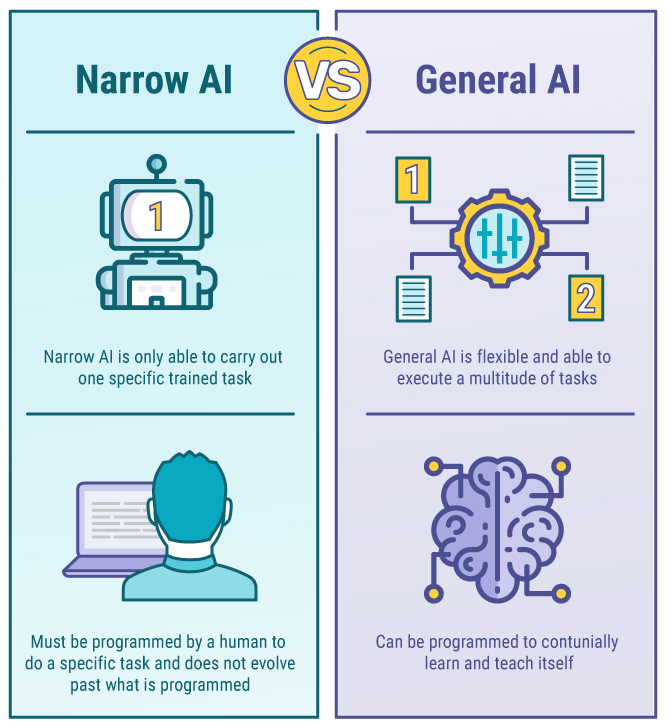Exploring the Possibilities of Artificial Intelligence
Discover the limitless potential of artificial intelligence in our latest article.
Artificial Intelligence (AI) has been a buzzword for decades now and with good reason. It's a fascinating field that has seen a lot of development and growth over the years. In this article, we'll explore the history of AI, the different types of AI, real-world applications, and the ethical considerations and challenges involved in this field. Let's dive in!
A Brief History of Artificial Intelligence
AI has been around for a long time, with the roots of the field dating back to the 1940s. John McCarthy coined the term "artificial intelligence" in 1955, and the goal of the field was to create machines that could solve problems that typically require human-level intelligence.
Early Beginnings and Pioneers
One of the earliest pioneers of AI was Alan Turing, who developed the Turing test in 1950 to determine if a machine could demonstrate intelligent behavior equivalent to, or indistinguishable from, that of a human.
Other early pioneers included Marvin Minsky, John McCarthy, and Claude Shannon. These researchers played a significant role in the development of the first AI programs, which focused on rule-based systems.
One of the earliest AI programs was the Logic Theorist, developed by Allen Newell and Herbert A. Simon in 1955. This program was able to prove mathematical theorems by searching through a set of logical statements.
Another early AI program was the General Problem Solver, developed by Newell and Simon in 1957. This program was able to solve a wide range of problems by representing them as a set of rules and then searching through those rules to find a solution.
The Rise of Machine Learning
In the 1980s and 1990s, AI experienced a resurgence, with the rise of machine learning algorithms. These algorithms could learn from data and improve their accuracy over time, paving the way for modern AI systems.
One of the earliest and most successful applications of machine learning was in the development of expert systems. These systems were able to make decisions and provide advice based on a set of rules and a large database of knowledge.
Another important development in machine learning was the creation of decision trees, which allowed machines to make decisions by following a set of rules and choosing the best path based on the available data.

Modern AI and Deep Learning
Today, we are seeing incredible advances in AI thanks to deep learning algorithms. These algorithms make use of neural networks, which are modeled after the structure and function of the human brain. Deep learning has led to breakthroughs in natural language processing, computer vision, and robotics.
One of the most famous applications of deep learning is in the development of self-driving cars. These cars use a combination of sensors and deep learning algorithms to navigate roads and make decisions in real time.
Another important application of deep learning is in the field of medical diagnosis. Deep learning algorithms are able to analyze medical images and make accurate diagnoses, potentially saving lives and improving patient outcomes.
Overall, the field of AI has come a long way since its early beginnings, and we can expect to see even more exciting developments in the years to come.
Understanding the Different Types of AI
Artificial Intelligence (AI) is a rapidly advancing field that has the potential to revolutionize the way we live and work. AI refers to the ability of machines to perform tasks that would typically require human intelligence, such as learning, problem-solving, and decision-making. There are two main types of AI: narrow AI and general AI.
Narrow AI vs. General AI
Narrow AI is designed to perform specific tasks, such as speech recognition, image classification, and playing chess. These systems are highly specialized and are trained to excel at a single task. General AI, on the other hand, is able to perform any intellectual task that a human can. This type of AI is still a work in progress and is considered to be the holy grail of the field.
While narrow AI is used extensively today, general AI is still a work in progress. Scientists and researchers are working tirelessly to create machines that can reason, understand complex concepts, and make decisions based on incomplete or ambiguous information.

Machine Learning and Neural Networks
One of the most exciting and rapidly advancing areas in AI is machine learning. Machine learning algorithms enable computers to learn from data, making them more accurate over time. These algorithms are used for a wide range of applications, including fraud detection, image recognition, and self-driving cars.
Neural networks are a type of machine learning algorithm that is modeled after the structure of the human brain. By mimicking the brain's neurons and synapses, neural networks are able to recognize patterns and make predictions with remarkable accuracy. They are particularly useful for tasks such as image recognition and natural language processing.
One of the key advantages of machine learning is that it allows computers to learn from experience. This means that as more data becomes available, machine learning algorithms become more accurate and better able to make predictions.
Natural Language Processing and Chatbots
Natural language processing (NLP) is a subfield of AI that deals with the interaction between humans and computers using natural language. NLP systems are used for a wide range of applications, including chatbots and virtual assistants. These systems are designed to understand and respond to natural language inputs, making them ideal for customer service, information retrieval, and other tasks.
Chatbots are computer programs that are designed to simulate conversations with human users. They are often used for customer service, where they can provide quick and efficient responses to common queries. Chatbots use natural language processing to understand the user's input and generate a response that is appropriate and relevant.
Virtual assistants, such as Siri and Alexa, are another example of NLP in action. These systems are able to understand natural language commands and perform a wide range of tasks, such as setting reminders, playing music, and providing weather updates.

In conclusion, AI is a rapidly advancing field with the potential to transform the way we live and work. From narrow AI systems that perform specific tasks to general AI systems that can reason and make decisions, the possibilities are endless. Machine learning and neural networks are enabling computers to learn from experience and make predictions with remarkable accuracy, while natural language processing is making it easier for humans to interact with machines in a more natural and intuitive way.
Real-World Applications of AI
Artificial intelligence (AI) is revolutionizing various industries, from healthcare to entertainment. AI is a branch of computer science that focuses on creating intelligent machines that can perform tasks that typically require human intelligence, such as perception, reasoning, and learning. Here are some of the real-world applications of AI:
AI in Healthcare and Medicine
AI is transforming the healthcare and medicine industry in many ways. One of the most significant applications of AI in healthcare is early disease detection. AI algorithms can analyze medical images, such as X-rays and MRIs, to detect signs of diseases like cancer and heart disease at an early stage. This can lead to faster and more accurate diagnoses, which can improve patient outcomes.
AI is also being used to develop personalized treatments for patients. By analyzing patient data, such as medical history and genetic information, AI algorithms can identify the most effective treatment options for individual patients. This can lead to better treatment outcomes and fewer side effects.
Another application of AI in healthcare is drug discovery. AI algorithms can analyze large amounts of data to identify potential drug candidates and predict their efficacy. This can speed up the drug development process and reduce costs.

AI in Finance and Banking
The finance and banking industries are also leveraging AI to improve processes and enhance customer experiences. One of the most significant applications of AI in finance is fraud detection. AI algorithms can analyze transaction data to identify patterns and anomalies that may indicate fraudulent activity. This can help financial institutions detect and prevent fraud more effectively.

AI is also being used for credit risk assessment. By analyzing customer data, such as credit history and income, AI algorithms can predict the likelihood of default and help financial institutions make more informed lending decisions.
Another application of AI in finance is customer service. Chatbots are being used extensively in these industries, providing customers with quick and accurate responses to their inquiries. This can improve customer satisfaction and reduce the workload of customer service representatives.
AI in Manufacturing and Supply Chain
In the manufacturing industry, AI is being used to optimize workflows, reduce costs, and improve quality control. AI algorithms can analyze production data to identify inefficiencies and areas for improvement. This can lead to more efficient and cost-effective manufacturing processes.
AI is also being used in the supply chain to improve inventory management. By analyzing sales data and other factors, AI algorithms can predict demand and optimize inventory levels. This can reduce waste and improve profitability.

Another application of AI in the supply chain is optimizing shipping routes. AI algorithms can analyze shipping data to identify the most efficient routes and modes of transportation. This can reduce shipping times and costs.
AI in Entertainment and Gaming
The entertainment and gaming industries are also seeing significant advances in AI. One of the most significant applications of AI in gaming is creating realistic game characters. AI algorithms can analyze human movement and behavior to create more lifelike characters.
AI is also being used to develop realistic physics engines. By simulating real-world physics, games can feel more immersive and realistic.

Another application of AI in entertainment is in the film industry. AI algorithms can generate special effects and create virtual characters that look and behave like real people. This can reduce the cost and time required to create special effects and make films more visually stunning.
Overall, AI is transforming various industries and enabling new possibilities. As AI technology continues to advance, we can expect to see even more exciting applications in the future.
Ethical Considerations and Challenges
Bias and Discrimination in AI Systems

One of the biggest ethical challenges in AI is the potential for bias and discrimination. AI systems can be trained on biased data, leading to biased outcomes. This can be particularly problematic in areas such as hiring and lending, where biases can result in discrimination.
Privacy and Security Concerns
Another major ethical concern in AI is privacy and security. AI systems can collect vast amounts of data, raising concerns about data privacy and security. Hackers can also exploit vulnerabilities in AI systems, causing significant harm.

The Future of Employment and AI
Finally, AI raises concerns about employment. While AI systems can automate many tasks, they could also lead to job displacement. It's important for policymakers to consider the potential impact of AI on employment and develop strategies to mitigate any negative effects.

Conclusion
AI is a fascinating field with incredible potential. From early pioneers to modern deep learning algorithms, the field has come a long way over the years. We've explored the different types of AI, real-world applications, and ethical considerations and challenges. As AI continues to evolve, it will be important to ensure that its benefits are balanced against its potential risks.

